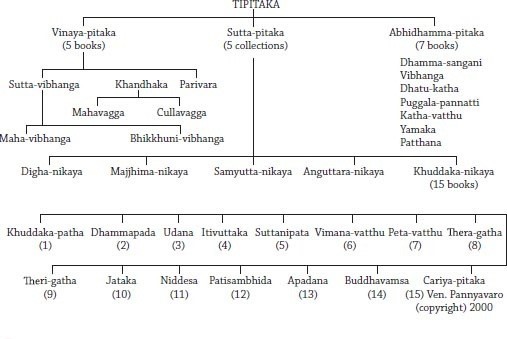- Gyankosh
- Current Affairs
- Value Addition
- PYQS
- Contact Page
- About Us
Buddhism – Early Literature
Early Buddhist Literature
- Divisions of Early Buddhist Literature:
- Canonical texts: These are directly associated with Gautama Buddha and form the foundational principles of Buddhism. They include texts like the Tipitakas (Three Pitakas), also known as the Pali Canon.
- Non-canonical texts: These are commentaries on canonical texts, philosophical dialogues, treatises, and historical accounts, written in Pali, Tibetan, Chinese, and other languages. Examples include the Milindapanho, Nettipakarana, Visuddhimagga, Nidanakatha, Dipavamsa, Mahavamsa, and Mahavastu.
Tipitaka/Tripitaka (The Three Baskets):
- Tipitaka (in Pali) and Tripitaka (in Sanskrit) refer to the Three Baskets or collections of Buddhist teachings. These texts were originally written on long, narrow leaves and transcribed by monks.
- Three sections of the Tipitaka:
- Sutta Pitaka (Basket of Discourses):
- Contains Buddha’s discourses on various doctrinal issues.
- Often called ‘Buddhavacana’ or the word of the Buddha as they are believed to be Buddha’s direct teachings.
- Accepted by most Buddhist schools.
- Arranged based on how the discourses were delivered.
- Vinaya Pitaka (Discipline Basket):
- Contains rules for monks and nuns in the monastic order (Sangha).
- Includes the Patimokka, a list of transgressions against monastic discipline, along with atonements for these transgressions.
- Also includes doctrinal expositions, ritual texts, biographical stories, and parts of the Jatakas (birth stories of the Buddha).
- Abhidhamma Pitaka (Basket of Higher Teachings):
- Provides an in-depth analysis and systematisation of the teachings of the Sutta Pitaka.
- Includes summaries, questions, answers, and lists to elaborate on Buddhist doctrines.
- Sutta Pitaka (Basket of Discourses):
Nikayas (Divisions of the Tipitaka):
- The Sutta Pitaka is further divided into five Nikayas (books):
- Digha Nikaya: Collection of long discourses.
- Majjhima Nikaya: Collection of medium-length discourses.
- Samyutta Nikaya: Collection of kindred sayings or related topics.
- Anguttara Nikaya: Collection of discourses arranged in numerical order.
- Khuddaka Nikaya: Smaller collection of texts, which includes:
- Jatakas: Stories of Buddha’s previous births.
- Dhammapada: Verses on ethical sayings and moral teachings.
- Niddesa: Expositions on the teachings.
- Buddhavamsa: History of the Buddha.
- Patisambhida: Analytical knowledge.
- Theragatha and Therigatha: Songs of Buddhist monks and nuns, respectively.
Important Non-Canonical Texts:
- Milindapanho:
- Written in Pali, it is a dialogue between Indo-Greek king Milinda (Menander) and the monk Nagasena on various philosophical issues.
- Nettipakarana (The Book of Guidance):
- Provides a connected account of Buddha’s teachings.
- Visuddhimagga (The Path to Purity):
- Written by Buddhaghosa, it deals with the progression from the purity of discipline to nibbana/enlightenment.
- Nidanakatha:
- The first connected life story of Buddha.
- Dipavamsa and Mahavamsa:
- Both written in Pali, they contain historical accounts of Buddha’s life, Buddhist councils, King Ashoka, and the arrival of Buddhism in Sri Lanka.
- Mahavastu:
- Written in mixed Sanskrit-Prakrit, it presents a hagiography of the Buddha or a sacred biography.

Early Buddhist Literature. Source – Ancient And Medieval India ( by Poonam Dalal Dahiya)


